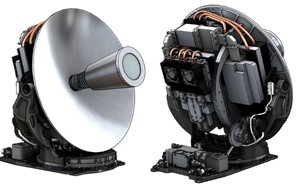- Sectors
- Aerospace & Defense
- Big science
- Fintech
- Insights

These days, many of the important innovations in space rely on leading-edge technologies on the ground, at sea, and in the air. Satellite “Earth Stations In Motion” (ESIMs) — with new antenna technologies for broadband, multi-domain mobility services — are the key to realizing value in today’s multi-band, multi-orbit world of new space.
Viasat and ARQUIMEA are pleased to announce a strategic collaboration that’s a perfect example of just that kind of innovation. Specifically, Viasat and ARQUIMEA are developing a dual-band antenna to allow users to roam between multi-band satellite constellations, providing assured connectivity even in congested and contested environments.
With cutting-edge aperture technology developed by the University Polytechnic of Madrid, the innovative dual-band antenna is designed specifically to be fitted easily on airborne mobility platforms (i.e., aircraft) and communicate with satellites in both X-band and Ka-band frequencies.
“Multi-band, multi-orbit, multi-network capabilities are critical enablers for the many nations with sovereign satellite constellations in those two bands,” said Stefan Jucken, Director, Global Solutions for Assured Mobility Services at Viasat.
“X-band is the traditional military satellite communications frequency band,” he said. “Historically, X-band has been chosen for its secure nature and ability to operate through any weather conditions. But today Ka-band can offer the benefits of secure and resilient capability, as well as abundant bandwidth and access to commercial subscription services.”
The X/Ka dual-band approach is the key differentiator for increasingly network-centric operations — providing the basis for assured, resilient, and anti-jam capable broadband communications to the warfighter, Jucken said.
The Spanish military’s next-generation SpainSat NG satellites, the first of which is due online in 2024, use X/Ka dual band, as does the U.S. military’s Wideband Global Satcom constellation (WGS). The strategic collaboration between Viasat and ARQUIMEA aims to deliver the capability and technology needed to support the Spanish Ministry of Defense.
“With this alliance, we will provide advanced SATCOM products and services enabling operations in a secure environment, providing cutting-edge technology and flexibility,” said Manuel Martín Flórez, General Manager of ARQUIMEA Aerospace & Defence.
“The new antenna is focused on giving the Spanish government the capability to conduct dual-band operations, primarily with airborne platforms,” said Daniel Quinones, Viasat Business Unit Director for Fixed Wing Intelligence, Surveillance and Reconnaissance. “It also augments C4/ISR mission capabilities for Spain’s military.”
Quinones added that it would also be very useful to existing U.S. and European users operating on the WGS network.
Viasat will contribute the Ka-band technology, while ARQUIMEA will provide the new dual X- and Ka-band aperture and X-band technology. Collaborating on the design and production of this technology enables Viasat and ARQUIMEA to offer the antenna to the Spanish military and other European defense and security customers which, for jurisdictional and regulatory reasons, have traditionally had to avoid U.S suppliers.
As a trusted company in Spain and Europe, ARQUIMEA has experience working with international space agencies such as NASA and the European Space Agency; defense and security ministries; NATO armed forces; and leading companies within the sector — as well as universities and other scientific and research institutions.
“I don’t think anyone questions Viasat products, but just like in the U.S., when it comes to defense and security applications, those agencies, for very understandable reasons, want to buy products built in their own countries,” Quinones said.
The Viasat component enables another advantage as well – the ability to connect to commercial networks when needed. Because commercial satellite communications providers also have Ka-band networks, antenna users will be able to ensure connectivity even when out of range of the Spainsat constellation.
“Let’s say there is a UN operation or a NATO operation in Africa and the Spanish military didn’t have coverage from SpainSat NG,” Quinones said. “They could seamlessly shift to the Viasat commercial network and get the connectivity they need.”
Add-on technology available with the antenna allows it to automatically route traffic via the best channel available, providing resilience when the going gets tough.
The airborne antenna is only the beginning. The new dual-band technology it’s based on can be applied in many different form factors, Quinones said.
“Our vision for this alliance with ARQUIMEA only begins with this airborne antenna. We want to go on to create derivative products for the maritime and land domains as well — all leveraging the same dual-band connectivity with the Spainsat NG constellation,” he said.